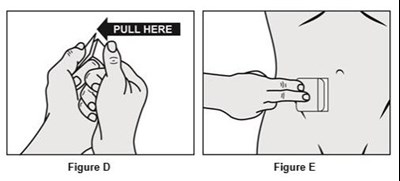Product Images Oxytrol
View Photos of Packaging, Labels & Appearance
- The structural formula for Oxybutynin is an antispasmodic, anticholinergic agent. Oxybutynin is administered as a racemate of R- and S-isomers. Chemically, oxybutynin is d, l (racemic) 4-diethylamino-2-butynyl phenylcyclohexylglycolate. The empirical formula of oxybutynin is C22H31NO3. - oxytrol 01
- Figure 1: Side and top views of the OXYTROL system.(Not to scale) - oxytrol 02
- Figure 2: Average plasma oxybutynin concentrations (Cp) in 24 healthy male and female volunteers during single-dose application of OXYTROL 3.9 mg/day to the abdomen, buttock, and hip (System removal at 96 hours). - oxytrol 03
- Figure 3: Average (SEM) steady-state oxybutynin and N-desethyloxybutynin plasma concentrations (Cp) measured in 13 healthy volunteers following the second transdermal system application in a multiple-dose, randomized, crossover study. - oxytrol 04
- Figure 4: Average plasma concentrations (Cp) measured after a single, 96-hour application of the OXYTROL 3.9 mg/day system (AUCinf/96) and a single, 5 mg, oral immediate-release dose of oxybutynin chloride (AUCinf/8) in 16 healthy male and female volunteers. - oxytrol 05
- · Do not use the same area for the patch for at least 1 week. You may choose to try different sites when using OXYTROL to find the sites that are most comfortable for you and where clothing will not rub against it. - oxytrol 06
- · Each patch is sealed in its own protective pouch. See Figure B.· When you are ready to put on your OXYTROL patch, tear open the pouch and remove the patch. See Figure C. - oxytrol 07
- · The sticky adhesive side of the patch is covered by 2 strips of overlapping protective liner. See Figure D.· Remove the first piece of the protective liner and place the patch, adhesive face down, firmly onto the skin. See Figure E. - oxytrol 08
- · Bend the patch in half and gently roll the remaining part onto your skin using the tips of your fingers. As you roll the patch in place, the second piece of the protective liner should come off the patch. See Figure F.· Apply firm pressure over the surface of the patch with your fingers to make sure the patch stays on. See Figure G. - oxytrol 09
- PRINCIPAL DISPLAY PANELOXYTROL® (oxybutynin transdermal system)NDC 0023-6153-083.9 mg/dayContains 8 transdermal systems - oxytrol 0a
Product Label Images
The following 10 images provide visual information about the product associated with Oxytrol NDC 0023-6153 by Allergan, Inc., such as packaging, labeling, and the appearance of the drug itself. This resource could be helpful for medical professionals, pharmacists, and patients seeking to verify medication information and ensure they have the correct product.
The structural formula for Oxybutynin is an antispasmodic, anticholinergic agent. Oxybutynin is administered as a racemate of R- and S-isomers. Chemically, oxybutynin is d, l (racemic) 4-diethylamino-2-butynyl phenylcyclohexylglycolate. The empirical formula of oxybutynin is C22H31NO3. - oxytrol 01

Figure 2: Average plasma oxybutynin concentrations (Cp) in 24 healthy male and female volunteers during single-dose application of OXYTROL 3.9 mg/day to the abdomen, buttock, and hip (System removal at 96 hours). - oxytrol 03

Figure 3: Average (SEM) steady-state oxybutynin and N-desethyloxybutynin plasma concentrations (Cp) measured in 13 healthy volunteers following the second transdermal system application in a multiple-dose, randomized, crossover study. - oxytrol 04

Figure 4: Average plasma concentrations (Cp) measured after a single, 96-hour application of the OXYTROL 3.9 mg/day system (AUCinf/96) and a single, 5 mg, oral immediate-release dose of oxybutynin chloride (AUCinf/8) in 16 healthy male and female volunteers. - oxytrol 05

· Do not use the same area for the patch for at least 1 week. You may choose to try different sites when using OXYTROL to find the sites that are most comfortable for you and where clothing will not rub against it. - oxytrol 06

· Each patch is sealed in its own protective pouch. See Figure B.· When you are ready to put on your OXYTROL patch, tear open the pouch and remove the patch. See Figure C. - oxytrol 07

· The sticky adhesive side of the patch is covered by 2 strips of overlapping protective liner. See Figure D.· Remove the first piece of the protective liner and place the patch, adhesive face down, firmly onto the skin. See Figure E. - oxytrol 08

· Bend the patch in half and gently roll the remaining part onto your skin using the tips of your fingers. As you roll the patch in place, the second piece of the protective liner should come off the patch. See Figure F.· Apply firm pressure over the surface of the patch with your fingers to make sure the patch stays on. See Figure G. - oxytrol 09

PRINCIPAL DISPLAY PANELOXYTROL® (oxybutynin transdermal system)NDC 0023-6153-083.9 mg/dayContains 8 transdermal systems - oxytrol 0a

OXYTROL is a medication that comes in a transdermal system form which contains oxybutynin as the active ingredient. It is prescribed through a prescription and the package and label contain important application instructions and should only be used as directed.*
* The product label images have been analyzed using a combination of traditional computing and machine learning techniques. It should be noted that the descriptions provided may not be entirely accurate as they are experimental in nature. Use the information in this page at your own discretion and risk.
